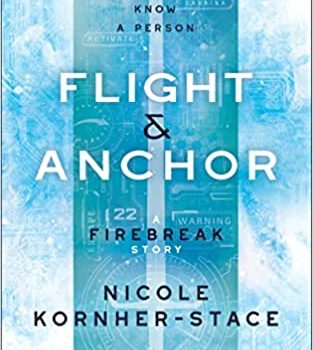Gary K. Wolfe Reviews Flight & Anchor by Nicole Kornher-Stace
 Flight & Anchor, Nicole Kornher-Stace (Tachyon 978-1-61696-392-7, $16.95, 192pp, tp) June 2023.
Flight & Anchor, Nicole Kornher-Stace (Tachyon 978-1-61696-392-7, $16.95, 192pp, tp) June 2023.
Superbright kids on the run, sometimes from shadowy institutions and sometimes with paranormal powers, have been a staple of SF at least since van Vogt’s Slan back in 1940, although an argument could be made that Wilmar H. Shiras’s 1950 fix-up Children of the Atom traces a more direct line to comparatively recent iterations like X-Men or The Umbrella Academy. Mutations from atomic radiation may have given way to trendier technologies like cloning or genetic engineering, but the principle remains the same: most adults, especially military or corporate types, are treacherous manipulators, and the kids need to learn to trust each other in order to survive. In Nicole Kornher-Stace’s Flight & Anchor, a prequel to her 2021 novel Firebreak, the 12-year-old protagonists are so dehumanized that they have numbers instead of names, like in We or Stranger Things: 06 is a resourceful but rebellious girl, and 22, a more cautious and circumspect boy. But as the story begins, they might as well be Hans Christian Andersen waifs, dangerously underdressed during a winter storm, until a kindly barista offers them shelter in her coffee shop. The barista, virtually the only secondary character in the novel, seems to offer a rare moment of human contact, but then disappears from the tale entirely. Soon the kids find a makeshift shelter in an abandoned shipping container, and for a while the tale seems a deliberate homage to the endless Boxcar Children series, and particularly the 1924 original by Gertrude Chandler Warner, which Kornher-Stace acknowledges, with some insightful comments, in an afterword. But, as readers of Firebreak will already know, this setting is light-years removed from the Norman Rockwell America of Warner’s original novel. Instead, it’s the ubercapitalist corporate dystopia which has replaced the United States in that earlier novel, and the kids are actually wholly owned, billion-dollar superweapons of the ruthless Stellaxis Corporation in its ongoing economic and political wars. “Each can take on a fifteen-ton mech in single combat. Survive a week without water, a month without food. Hear sounds beyond a human’s range,” etc.
We learn this, mostly in fragments and allusions, when the point of view occasionally shifts to that of the Director, who seems to be the only officer of the corporation to realize that their high-profile assets have gone on the lam, and who is frantically trying to get them back before her bosses find out. But even though she can track them and even monitor their vital signs, simply abducting them would be bad optics, not to mention hazardous. Instead, she enlists the aid of an ancient AI space probe called SABRINA, which takes the form of a shapeshifting nanobot array (and which is apparently borrowed from Kornher-Stace’s middle-grade novel Jillian vs. Parasite Planet). SABRINA effectively becomes the novel’s fourth character, and its delightfully independent voice is something of a reprieve from the grim determination of the Director and the claustrophobic feeling of the kids in their makeshift bunker, even though its plot function and sometimes its appearance suggest a sort of nanobot Tinker Bell.
Much narrower in scope than Firebreak, Flight & Anchor feels almost stripped down to essentials, mostly confined to the points of view of its three main characters and only occasionally offering glimpses of a wider world, such as that coffee shop or a Comforts of Home megastore that the kids visit for supplies. At times, Kornher-Stace seems so bent on narrative efficiency that she resorts to using bullet points or numbered lists that read like Post-it notes, not all of which add to the plot. There’s little direct evidence of the oppressive dystopian setting of the earlier novel, and in fact it’s reasonable to ask how much of a standalone tale this one actually is. At the archetypal level of bright kids on the run from an evil corporation – that tradition I mentioned earlier – it’s a well-realized adventure with likeable protagonists. But only a few chapters in, a few pointed allusions to the future begin to show up – the Director misjudging 22 “chronically thus far, fatally a few years hence”; or “The thought that will return to the Director unbidden, eight years down the line, standing in an elevator with minutes to live” – strongly suggest that reading Firebreak might well explain some apparent loose ends in Flight & Anchor, including its ending. Indeed that is the case, and the earlier novel does fill in some gaps and clarify some allusions. With its emphasis on gaming and stark corporate greed, Firebreak is a very different sort of novel, but if it’s not quite a prerequisite to understanding the dynamics at work in Flight & Anchor, it adds considerable depth and texture to what otherwise is simply a pretty good iteration of a pretty old trope.
Gary K. Wolfe is Emeritus Professor of Humanities at Roosevelt University and a reviewer for Locus magazine since 1991. His reviews have been collected in Soundings (BSFA Award 2006; Hugo nominee), Bearings (Hugo nominee 2011), and Sightings (2011), and his Evaporating Genres: Essays on Fantastic Literature (Wesleyan) received the Locus Award in 2012. Earlier books include The Known and the Unknown: The Iconography of Science Fiction (Eaton Award, 1981), Harlan Ellison: The Edge of Forever (with Ellen Weil, 2002), and David Lindsay (1982). For the Library of America, he edited American Science Fiction: Nine Classic Novels of the 1950s in 2012, with a similar set for the 1960s forthcoming. He has received the Pilgrim Award from the Science Fiction Research Association, the Distinguished Scholarship Award from the International Association for the Fantastic in the Arts, and a Special World Fantasy Award for criticism. His 24-lecture series How Great Science Fiction Works appeared from The Great Courses in 2016. He has received six Hugo nominations, two for his reviews collections and four for The Coode Street Podcast, which he has co-hosted with Jonathan Strahan for more than 300 episodes. He lives in Chicago.
This review and more like it in the June 2023 issue of Locus.
 While you are here, please take a moment to support Locus with a one-time or recurring donation. We rely on reader donations to keep the magazine and site going, and would like to keep the site paywall free, but WE NEED YOUR FINANCIAL SUPPORT to continue quality coverage of the science fiction and fantasy field.
While you are here, please take a moment to support Locus with a one-time or recurring donation. We rely on reader donations to keep the magazine and site going, and would like to keep the site paywall free, but WE NEED YOUR FINANCIAL SUPPORT to continue quality coverage of the science fiction and fantasy field.
©Locus Magazine. Copyrighted material may not be republished without permission of LSFF.







